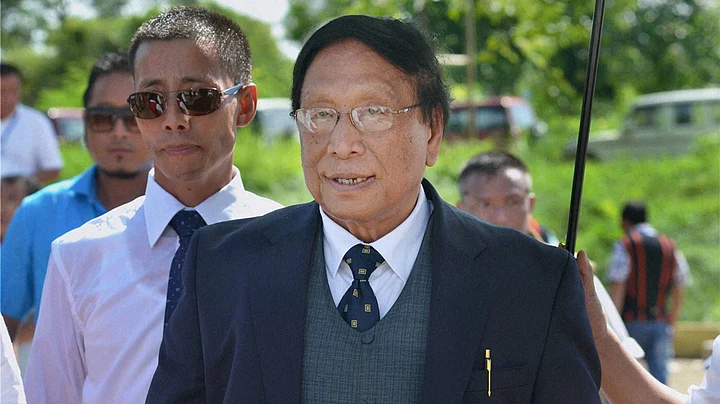Unrest over Peace Accord
- Recently signed Naga Peace Accord has raised speculation among some states particularly Nagaland’s neighbouring states of Manipur and Arunachal Pradesh
- It has turned into a Kuki versus Naga tussle with the former rejecting the agreement and the latter welcoming it
- The 2001 ceasefire agreement had also resulted in discontent among the non-Nagas
- A contentious issue is that of the Autonomous District Councils (ADCs) in the hilly areas that continue to lack financial and legislative powers.
- Need to watch how much autonomy is granted to different communities, the Nagas, Kukis, Muslims and Meiteis
There is no doubt that the framework agreement for peace, signed on August 3 between the Centre and the Nationalist Social Council of Nagaland (Isak-Muivah), is historic as well as welcoming as a precursor to finding lasting peace in conflict-ridden northeast India. However, by choosing not to reveal the terms of agreement, it has raised speculation of a hidden agenda, particularly in Nagaland’s neighbouring states, Manipur and Arunchal Pradesh, which have sizeable Naga population.
NSCN(IM) General Secretary Thuingaleng Muivah hails from Manipur where the latest accord is being viewed with intense suspicion in respect of the state’s territorial integrity.
While NSCN(IM)’s persistent demand for some kind of sovereignty finds no opposition even in Manipur, the demand for integration of all Naga-inhabited areas in the northeast under one single administrative unit is vehemently objected to in Assam, Arunachal Pradesh and Manipur. The three states are against any move to re-drawing of their maps to create a greater Nagaland or Nagalim.
Government’s Assurance
The June 2001 ‘uprising’ in which 18 protestors died in police action is a glaring example of how the Naga integration issue is viewed by non-Nagas in Manipur. In 2001, the Centre and NSCN(IM) declared in Bangkok that the ceasefire agreement between them was without territorial limits. Manipur’s non-Nagas, particularly the valley people, rose in anger, demanding expunging of the three words ‘without territorial limits.’
The disturbance involved setting the state legislative assembly building on fire. Offices of political parties were targeted and even the chief minister’s official residence-cum-secretariat was attacked. Eventually, the Centre expunged the three words.
Johnson Elangbam, President of the United Committee Manipur (UCM), an influential civil society body which took upon itself to protect Manipur’s territorial integrity, said: “Since 2001, NSCN(IM) and the government of Nagaland through its resolutions have been persistent in their demand of integration all Naga inhabited Areas in the northeast under one administration. Government of India must be very clear that Manipur did not merge to the Indian Union at the mercy of anyone else. Manipur joined the Indian Union by way of a signed merger agreement treaty that acknowledged the political boundary of Manipur. If this uniqueness is not respected and honoured by the government of India, it will be very wrong.”
Naga Aspirations
In Manipur’s Ukhrul, Muivah’s home district, hundreds of people participated in the thanksgiving organised to commemorate the signing of the peace accord. Leiyolan Vasum, General Secretary, Tangkhul Katamnao Saklong, an apex Tangkhul Naga Students Union, described the signing as one of the steps to realise their aspiration.
“An aspiration to live together as one community under one single administrative umbrella. This peace accord will lead to a future where we can live together as a separate entity, separate from the government of India, not as Indian but as Nagas,” he said.
Uneasy Kukis
While the Nagas of Manipur are hailing the agreement, the Kukis, who also inhabit a sizeable part of the hill areas of Manipur rejected the agreement, calling it a shocking development. This was stated by the Kuki Inpi Manipur, KIM, the highest body of the Kukis of Manipur.
“Kuki Inpi Manipur is sorry to say that we cannot accept this peace accord which glares of a hidden agenda. The Kuki Inpi stands firmly in its resolve that the government of India should deliver justice to the 905 Kukis killed, 100,000 rendered homeless by the NSCN(IM) during the ethnic cleansing programme of 1990’s before settling the Naga issue,” said KIM General Secretary Khaimang Chongloi.
Beyond Autonomy?
Of Manipur’s nine districts, five are located in the hills and four in the valley. While 90% of the total area is hilly, plains constitute 10%. All communities, Nagas, Kukis, Muslims, Meiteis and others, coexist. The hills areas have been declared Autonomous District Councils (ADCs) for their self-government. However, despite repeated promises and assurances, the ADCs continue to lack financial and legislative powers. Many developmental activists claim that extending more powers to the ADCs is the logical way to address economic disparity between the hills and plains.
According to the Centre, the terms of the agreement between the NSCN(IM) and itself will be made public once the final peace treaty is drafted. This is expected to happen in about three months. Given the fact that sovereignty or autonomy and some sort of socio-cultural, political, economic integration of the Nagas areas form the core demands of the NSCN(IM), it would be interesting to watch how much autonomy a particular community is granted within India’s federal mechanism.
(The writer is a freelance journalist and a documentary filmmaker based in Manipur)
(At The Quint, we question everything. Play an active role in shaping our journalism by becoming a member today.)
